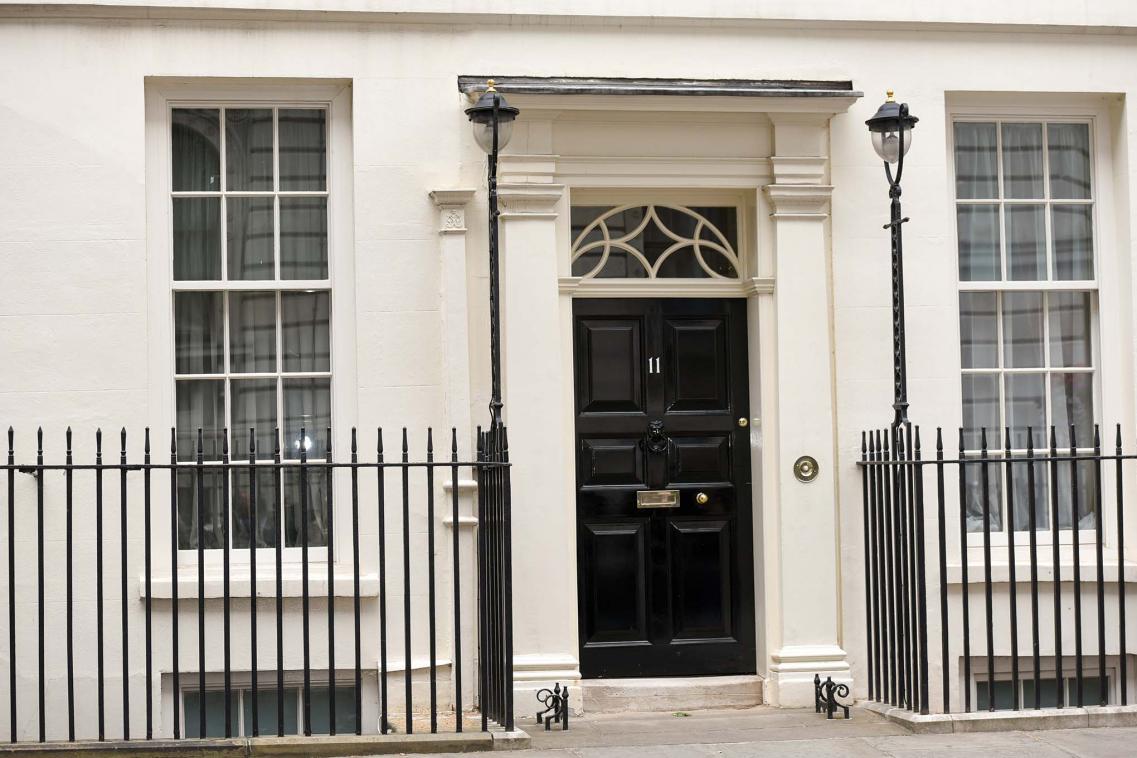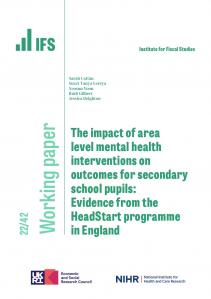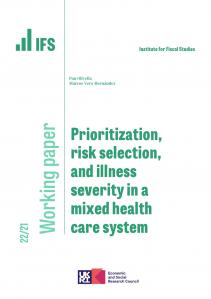Collection

Rigorous analysis on the choices facing the Chancellor at the 2022 Spring Statement, from the Institute for Fiscal Studies.
In the Spring Statement, the Chancellor gives the country an update on the health of the economy, responding to the most recent forecast from the Office for Budget Responsibility. The Spring Statement also gives the government an opportunity to consider longer-term challenges to the UK’s public finances, and to start consulting on how to address them.
Event
Spring Statement 2022
Thurs 24 March 2022 | 10:15 - 11:45 | Online
Slides from the event
Outlook for the public finances by Carl Emmerson
Spending on public services: an ominous silence? by Ben Zaranko
Incomes and personal tax and benefit measures by Robert Joyce
It’s a little too easy in responding to yesterday’s Spring Statement to forget even the very recent past. Remember Covid? The £70 billion furlough scheme only came to an end less than six months ago. The economy is still in recovery mode. That was the biggest economic shock in a century, sent government debt and borrowing spiralling to record levels and involved greater government intervention in the economy than at any moment in peacetime.
And if we can’t remember Covid, what about Brexit? The OBR sees no reason to revise its view that it will have a substantial long-term negative effect on our national income. Then there’s the ever-lengthening shadow of the financial crisis, which resulted in a decade and more of stagnant incomes and flat lining productivity.
All that history matters in assessing both the severity of the current problems and the chancellor’s response to them. Covid left the deficit, and especially the national debt, higher. Public service spending was squeezed tight after 2010 and the working age benefit system was made much less generous. Brexit has slowed growth, on top of the post financial crisis slowdown. Household incomes today are far lower than they would have been in the absence of these shocks. On some measures average earnings could have been as much as £11,000 a year higher had pre-financial crisis trends continued.
So, neither the nation’s finances nor household finances were in great shape when the latest economic shock – the worldwide rise in commodity prices – hit. The expected sharp fall in real household incomes this year is all the more difficult, and all the more shocking, coming off the back of such a long period of feeble growth. And a chancellor looking both to balance the current budget and provide at least a little succour to public services after the austerity years had very little room for manoeuvre.
Public finances
In fact, Mr Sunak has proved to be something of a fiscal illusionist. He told us that he cut taxes yesterday. In a sense he did. He increased the floor for NICs and promised a cut in income tax in 2024. So Mr Sunak’s statement contained big new tax cuts. But it also allowed taxes to rise. He can now expect to raise more in tax as a share of national income by 2025 than he expected last October. In fact, taxes are set to rise to their highest level as a fraction of national income since Clement Attlee was prime minister. Not my comparison, that comes directly from the OBR.
On current plans Mr Sunak’s income tax changes won’t actually depress income tax revenues in 2024-25. Despite the cut in the basic rate planned for that year, the income tax take will stay about the same as in the previous year, and then continue rising. That’s the effect of inflation and fiscal drag. They have magically doubled the scale of the tax rise he announced last year – the four-year freeze in the personal allowance and higher rate threshold. The proposed cut in the basic rate gives back only about half of the additional windfall he is now expecting to enjoy from that measure.
There’s another illusion in there too – the annually repeated illusion that fuel duties will actually rise next year. Not only do the public finance forecasts depend upon the 5p cut being reversed, they assume an increase in line with the RPI on top of that. The odds against the former feel long. I reckon an RPI increase on top is about as likely as my winning the National Lottery. And I don’t play the Lottery.
Given all that, by the end of the forecast period the chancellor supposedly has a little more wriggle room against his fiscal targets than he expected in October despite lower expected economic growth and those tax cuts. That’s because not only is he allowing taxes to rise (he’s not cutting them), he is also effectively cutting spending on public services in real terms relative to previous plans. Yesterday he offered them no extra cash at all to deal with higher inflation. The exact scale of this cut relative to previous plans is a little uncertain, but it is significant. It will almost certainly mean some more hefty real pay cuts across the public sector, coming on top of cuts both in real terms and relative to the private sector over the last 12 years.
Cost of living
The immediate aim of the statement, of course, was to help relieve the squeeze on the cost of living.
What was announced yesterday comes on top of February’s £9 billion giveaway via council tax rebates for 80% of households and the, repayable, rebate on energy bills. But, of course, it also comes on top of the NI increase announced in October and the freezing of the income tax personal allowance and thresholds announced a year ago. Put all those together and the net effect of the measures is a relatively modest giveaway to households of in the order of £5 billion or so in 2022-23.
Against the baseline of normal uprating, it is a pretty progressive giveaway. People in the top 10% or so of the income distribution lose quite heavily. As a fraction of income, gains from the measures are highest at the bottom and gradually fall with income. The council tax and energy bill rebates play an important role here. That is a definition of a progressive set of measures. Those of us who have criticised the Chancellor for failing to do more for benefit recipients should acknowledge that.
The problem is that this will still not be enough to protect poorer households from a significant hit to their living standards. In particular the failure to do more than default indexation for benefits will leave many worse off.
In the long run this year’s giveaway turns into a substantial takeaway. The overall impact of the reforms remains progressive. But the council tax and energy bill rebates disappear leaving only very small gains at the bottom (largely arising from the cut in the UC taper). The NI floor, having been increased sharply this July, is frozen through to March 2026. The impact of freezing income tax allowances and thresholds grows, taking an increasing amount from higher earners. Cutting the basic rate of income tax is regressive but, as we have seen, not as big a change as those freezes. The big increase in National Insurance Contributions remains a big hit on higher earners who are still the big losers. Perhaps surprisingly this continues a trend since 2010: the highest earners have been by a distance the biggest losers from tax changes implemented since then.
In the short term one problem is that this combination of tax cuts and rebates is not enough to offset the fall in real earnings that we expect to see. It looks like a median earner, on around £27,500 a year will be about £360 worse off in the next financial year than in the current year. Someone earning around £40,000 will be getting on for £800 worse off. As I’m sure everyone is now well aware the OBR are forecasting the biggest hit to real household disposable income per person since comparable records began in the 1950s.
The second big problem is that for those dependent on benefits there was nothing in yesterday’s package. The flat rate council tax rebate will benefit the large majority to the tune of £150 and the energy bill rebate will provide £200 in the short term. But that will still not be enough to offset the real fall in the value of benefits for most such households over the coming year. The 3.1% increase needs to be set against OBR expectations of inflation averaging nearly 8% over the year. And the inflation rate experienced by poorer households will be even higher than that. While benefit levels will catch up with inflation next year, that will be of little comfort to those budgeting week to week or to those who are unemployed this year but not next year. It is hard to understand the lack of action on this front.
A couple of additional specific beefs with the policy announcements. First, while the increase in the NI floor is welcome, it is hard to think of any good reason to increase the rate of NI and cut the rate of income tax. That again benefits those living off pensions and unearned incomes at the expense of workers. The Chancellor has also not made the case for cutting the basic rate whilst also cutting the value of the personal allowance and it is certainly a regressive policy combination.
Second, the absurdity of the idea that the NI increase, which will become the health and social care levy, is in any way hypothecated to health and social care was laid even more bare yesterday. The cut in NI receipts from yesterday’s new measure is not leading to, and of course should not lead to, a cut in funding for the NHS and social care.
Third, while promising some changes to business taxation in his Autumn Budget Mr Sunak has done nothing to shield them from this year’s planned rise in employer NICs. That will add to their costs and to the downward pressure on real wages.
One additional point worth making. The impact of the change to the student loan repayment system on the public finances was laid out in the OBR’s report. This will effectively act as an increase in taxes on middle earning recent graduates.
Assessment
To be fair to Mr Sunak he has been caught in a bind. We are worse off than we expected and he could never protect us all. What he has proposed will offer substantial protection to low earners and, from last month’s measures, some significant protection to those on benefits. His policies are overall progressive and will take significantly more from those on the highest incomes. He continues to, just about, meet his fiscal rules.
However. He has not taken the opportunity to protect the poorest more fully simply by uprating their benefits more closely in line with actual inflation. His choice to increase NI rates and reduce the basic rate of income tax looks indefensible from an economic point of view, though one can see the political attractions. He continues, despite his rhetoric, to be a chancellor presiding over a very big increase in the tax burden. What he did yesterday was not enough even to stop the expected tax burden rising yet further.
He is sharing the inevitable pain of continued bad news between public services and taxpayers, with benefit recipients suffering in the short term. He had tough decisions to make. Other choices were available.
Weds 23 March 2022
IFS Director Paul Johnson said:
“There are two paradoxes at the heart of today’s statement. The Chancellor has managed to announce tax cuts without reducing the planned tax take from previous plans. And by saying nothing about spending, he is reducing the real-terms generosity of his plans for spending on public services. That’s what inflation does.
The cuts to income tax and National Insurance are effectively paid for by increasing revenues as a result of fiscal drag. The freezing of the income tax personal allowance and higher rate threshold turn out to be much bigger tax rises than first intended. As a result, almost all workers will be paying more tax on their earnings in 2025 than they would have been paying without this parliament’s reforms to income tax and NICs, despite the tax cutting measures announced today. And by keeping to previously announced cash plans for public spending Mr Sunak is being considerably less generous to public services than he intended when he set out his spending plans in the Autumn.
If he wants to be remembered as a tax reforming chancellor, so far he is headed in the wrong direction. The combination of increased NI rates and a reduced income tax rate will make the tax system both less equitable and less efficient. It will increase the wedge between higher taxes on earnings and lower taxes on pensions and unearned incomes.
But perhaps what really stands out today is what was missing. In the face of what the OBR calls the biggest hit to household finances since comparable records began in 1956-57 he has done nothing more for those dependent on benefits, the very poorest, besides a small amount of extra cash for local authorities to dispense at their discretion. Their benefits will rise by just 3.1% for the coming financial year. Their cost of living could well rise by 10%.”
Initial reaction from IFS researchers - in full
Taxes and incomes
The Chancellor today announced cuts to National Insurance contributions (NICs) and income tax. That follows big rises announced to both taxes over the previous year. He has added a cut to the basic rate of income tax (from 2024) and an increase in the NICs threshold (from July 2022) to pre-announced cuts (in real terms) to income tax thresholds and a rise in the rate of NICs. The net effect is to create some who gain overall and some who lose.
For NICs, the threshold at which workers start paying the tax will rise to £12,570 (in line with income tax). That follows a previously announced increase in the main rate of NICs from 12% to 13.25% due to kick in next month. For income tax, we have essentially a mirror image: the Chancellor today announced a cut in the basic rate from 20% to 19% in April 2024, occurring alongside the already-announced four year freeze which runs to 2025-26(and therefore sizeable real terms cut) in the thresholds.
What do these reforms mean for tax liabilities and incomes?
For the coming year as a whole (2022-23), those earning between around £10,000 (the current NICs threshold) and £25,000 will pay less tax on their earnings as a result of these changes. Those earning more than £25,000 will pay more, due to the combined effect of freezing income tax thresholds and increasing the NICs rate.
By 2025-26 - after the cut to the basic rate of income tax has been implemented and thresholds have continued to be frozen - virtually all workers will be paying more tax on their earnings than they would have paid without these changes to rates and thresholds. This is because freezing thresholds for four years is now set to have such a large impact, given the rise in expected inflation over this period.
The Office for Budget Responsibility’s forecast is, as expected, for earnings growth to be very weak in the near term, falling by around 2.5% in real terms in 2022-23 - which would be the largest one year drop in real earnings since the late 1970s. This follows around 14 years of very meagre growth in earnings, and means that the average worker is no better off than they were in 2008.
Bringing together the expected changes in earnings, the reforms to taxes, and the energy measures announced in February, a median (middle) earner on £27,500 per year can expect to be about £360 worse off this year than they were last. A full-time worker on the National Living Wage fares a little better (gaining £140) because of the NLW rising by more than average earnings (though less than inflation) and because of the increase in the NICs threshold. Things are likely to be much tougher for those out-of-work on state support (including pensioners). Inflation is expected to average 8% this year, whereas benefits are due to only go up by 3.1%, implying a (temporary) cut in the real value of benefits of about 5%. The flat rate support for rising energy costs will offset some of that, but in most cases only partially.
Tom Waters, a Senior Research Economist at IFS, said:
“The Chancellor is today giving with one hand in tax, having previously taken away with the other. When all is said and done, the reforms imply a greater level of tax for almost all workers - especially those on higher earnings. In the nearer term, many households are likely to see real-terms declines in their incomes with both earnings and benefits failing to keep up with inflation.”
On the public finances
Strong receipts in the financial year just ending continue into the rest of the forecast horizon. Changes to the economic environment, and in particular much higher inflation, added £33 billion to forecast receipts in the coming year.
But these higher revenues are entirely eaten up by the increased cost of servicing the quarter of the government’s debt stock that is index-linked. Inflation alone is set to add £32 billion to the debt interest bill, with a further £10 billion coming from higher Bank Rate and the sale of some of the assets held under Quantitative Easing by the Bank of England.
New measures announced in the Spring Statement - most notably the cut to fuel duties and the increase in the point at which employees’ National Insurance contributions are paid - adds a further £10 billion to borrowing in the coming year.
Over the medium-term the impact of higher inflation on debt interest is forecast to fall sharply. And the forecasts are predicated on the 5p cut to fuel duty being reversed. This allowed the Chancellor to announce a cut to the basic rate of income tax in April 2024 and still expect the difference between total receipts and day-to-day spending in 2024-25 to be £6 billion bigger than forecast last October.
Public spending
Today’s statement contained no major announcements concerning public spending. Instead, the Chancellor stuck to the cash settlements agreed with departments at last October’s Spending Review, and declined to announce an increase in spending on working-age benefits or pensions. But higher inflation means that those cash settlements are now worth less in real terms – though growth in the GDP deflator (the relevant measure of inflation for the public finances) is forecast to be considerably more muted than in CPI inflation.
Rather than growing by an average 3.3% per year in real terms over the next three years, as was planned in October, the latest forecasts imply that day-to-day public service spending will grow by 2.9% per year instead. The Chancellor’s spending plans are therefore around 10% less generous than he originally intended them to be.
The NHS England budget is now set to grow by 3.6% per year, down from 4.1% under October forecasts, and the schools budget by 1.7% per year, down from 2.2%.
To compensate public services fully - thereby maintaining the real-terms growth rate he announced in October - he’d need to top up his plans for 2024-25 by around £7 billion.
Ben Zaranko, Senior Research Economist at the IFS, said:
“Soaring inflation means a sizeable unintended cut to the generosity of the Chancellor’s spending plans for public services, for the simple reason that the same cash budget can now purchase less in the way of goods and services. Higher inflation has wiped out more than 10% of the real-terms increase he pencilled in last October. Notably, the Ministry of Defence will see the real value of its budget fall between this year and next.
This poses a significant challenge for the Chancellor – though one that he was perhaps wise not to tackle today. It makes more sense to wait for greater clarity on energy prices and pay settlements before making any necessary adjustments in the autumn. If no additional funding is forthcoming, because any fiscal headroom is instead dedicated to pre-election tax cuts, public services will feel the squeeze.”
Fuel duties
Stuart Adam, Senior Economist at the IFS, said:
“A temporary 5p/litre cut in fuel duties is a well targeted way to partly cushion the big rise in petrol and diesel prices we have seen. As long as it is genuinely temporary, the environmental and fiscal costs are bearable. But history suggests it would not be a surprise if the Chancellor failed to restore fuel duties next year to their previously planned level. If the new, lower, level of fuel duties is kept next year – coming on top of more than a decade of freezes – it will leave the duty rate in 2023–24 a third lower than if it had kept pace with CPI inflation since 2010–11, costing the government £13 billion a year.”
Related content

Boris Johnson and Rishi Sunak have announced tax rises worth 2% of GDP in just two years – the same as Tony Blair and Gordon Brown did in ten
17 March 2022

Sunak could delay the pain for households but he can’t take it away
14 March 2022

The even longer squeeze on teacher pay
11 March 2022

Senior Economist
Stuart is a Senior Economist working in the Tax sector, and focuses on analysing the design of the tax and benefit system.

Deputy Director
Carl, a Deputy Director, is an editor of the IFS Green Budget, is expert on the UK pension system and sits on the Social Security Advisory Committee.

Director
Paul has been the Director of the IFS since 2011. He is also currently visiting professor in the Department of Economics at University College London.

Deputy Director
Robert is a Deputy Director. His work focuses on primarily on the labour market, income and wealth inequality, and the design of the welfare system.

Associate Director
Tom is an Associate Director at the IFS and Head of the Income, Work and Welfare sector.

Senior Research Economist
Ben is a Senior Research Economist and an editor of the IFS Green Budget. His work focuses on the health and social care system and UK fiscal policy.
Collection details
- Publisher
- IFS
More from IFS
Understand this issue

Election Special: Your questions answered
27 June 2024

Election Special: The big issues politicians haven't spoken about
25 June 2024

Cuts to council services likely unless cost pressures abate – even with the biggest council tax increases for 20 years
21 June 2024
Policy analysis

How would the parties’ tax and spending plans affect Scotland and Wales?
28 June 2024

How should we interpret parties’ public spending pledges this election?
23 June 2024

Main parties’ manifestos tell us little about the funding individual public services would actually receive
23 June 2024
Academic research

Do work search requirements work? Evidence from a UK reform targeting single parents
1 February 2023

The impact of area level mental health interventions on outcomes for secondary school pupils: Evidence from the HeadStart programme in England
13 October 2022

Prioritization, risk selection, and illness severity in a mixed health care system
16 June 2022